Takht-e Rostam, also known as the Stupa of Takht-e Rostamis, is a significant archaeological site located 2 kilometers south of the town of Haibak, Afghanistan. Dating back to the 3rd-4th century AD, it was constructed during the era when the region was part of the Kushano-Sasanian Kingdom. This remarkable complex offers a fascinating glimpse into the early Buddhist architecture and history of Afghanistan. Follow archeology.dulichvn.net to discover many hidden mysteries that have yet to be discovered.
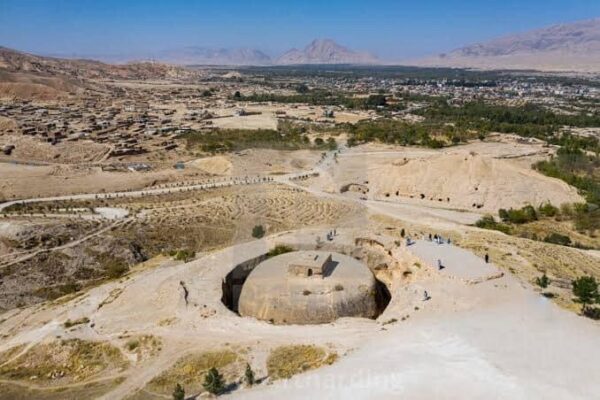
The Historical Significance of Takht-e Rostam
The Kushano-Sasanian Kingdom: A Fusion of Cultures
The construction of Takht-e Rostam took place during the reign of the Kushano-Sasanian Kingdom, a period marked by a unique fusion of Iranian and Indian cultural influences. This era saw the convergence of two distinct civilizations: the Iranian Sasanian Empire and the Indian Kushan Empire. As a result, the Kushano-Sasanian Kingdom became a melting pot for religious, artistic, and architectural traditions from both regions.
In the realm of religion, the Kushano-Sasanian Kingdom played a pivotal role in the spread of Buddhism throughout Central Asia. The region became an important cultural and spiritual crossroads, where the doctrines and iconography of Buddhism were intertwined with local Iranian and Central Asian traditions. The construction of the Takht-e Rostam complex, with its stupa and sanctuaries, exemplifies this commitment to the promotion and preservation of Buddhist practices. It serves as a lasting reminder of how the Kushano-Sasanian rulers not only embraced Buddhist beliefs but also facilitated their dissemination across the vast expanse of Central Asia.
Early Buddhist Architecture: A Masterpiece of Carved Stone
The architectural marvel of Takht-e Rostam is a stunning example of early Buddhist design, meticulously carved directly into the bedrock of the surrounding hills. This method of construction, known as rock-cut architecture, is both practical and symbolic, allowing the structure to harmonize with the natural landscape while also serving as a lasting testament to the builders’ skill. The complex consists of five chambers, two of which are designated as sanctuaries, each offering a unique window into the religious life of the time.
The sanctuaries of Takht-e Rostam are particularly significant, as they reveal the intricacies of early Buddhist ritual practices. The chambers are adorned with a combination of simple yet profound carvings, including motifs that would have held deep spiritual meaning for the worshippers. These sacred spaces were likely used for meditation, prayer, and other religious ceremonies, serving as centers for both personal reflection and communal worship.
The advanced craftsmanship on display at Takht-e Rostam speaks to the sophisticated knowledge and techniques employed by the architects and artisans of the Kushano-Sasanian Kingdom. The precision of the carvings, the harmony between the structure and the natural environment, and the intricate attention to detail all point to a deep understanding of both architectural design and spiritual symbolism.
The Stupa: A Symbol of Enlightenment and Spiritual Practice
At the heart of the Takht-e Rostam complex stands the stupa, an iconic Buddhist structure that symbolizes the path to enlightenment. The stupa is not merely a physical monument; it represents the core of Buddhist philosophy, encapsulating the journey toward spiritual awakening and the transcendence of worldly desires. Its towering presence in the complex signifies its importance as both a religious and cultural center.
In Buddhist tradition, stupas were built to house sacred relics and to serve as focal points for meditation and contemplation. The stupa at Takht-e Rostam likely fulfilled this role, offering the local community a place of profound spiritual significance. Pilgrims and worshippers would have visited the site to engage in prayer, meditation, and other devotional practices, seeking to attain a deeper understanding of Buddhist teachings.
The stupa’s role as a symbol of enlightenment extends beyond its physical form. Its very existence within the Takht-e Rostam complex illustrates the enduring impact of Buddhism in the region during the Kushano-Sasanian period. The monument’s central position within the site underscores its importance as a religious and cultural landmark, inviting visitors to reflect on the path to spiritual awakening. The stupa, with its architectural elegance and profound symbolism, remains one of the most powerful features of the Takht-e Rostam complex, embodying the timeless principles of Buddhism for generations to come.
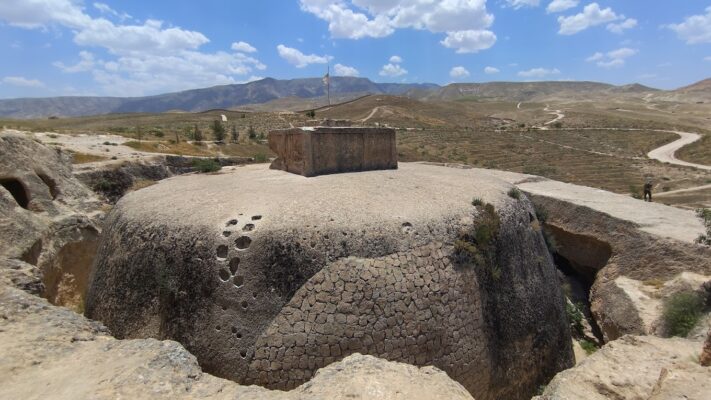
Architectural Features of Takht-e Rostam
The Carved Bedrock Chambers: A Marvel of Rock-Cut Architecture
The most remarkable feature of the Takht-e Rostam complex is its extraordinary construction, where every part of the site, including its five chambers, has been carved directly into the solid bedrock of the surrounding hillside. This method of rock-cut architecture is not only a testament to the ingenuity and craftsmanship of the builders but also reflects a profound connection to the natural world. By integrating the structure with the landscape, the architects ensured that the complex harmonized with its environment, creating a seamless blend of human creativity and nature’s grandeur.
The five chambers of the complex serve a variety of functions, with two of them designated as sanctuaries. These sacred spaces were likely used for meditation, religious rituals, and communal gatherings. The chambers’ design, with their deep recesses and carved details, provides a sense of the scale and purpose of the site, offering visitors a glimpse into the spiritual and architectural significance of the complex. The way the site emerges from the rock, as if it were part of the landscape itself, emphasizes its enduring connection to both the natural world and the spiritual realm.
The Domed Ceiling with Lotus Leaf Decoration: A Symbol of Spiritual Enlightenment
One of the most striking features within the Takht-e Rostam complex is the chamber with a domed ceiling, beautifully adorned with intricate lotus leaf decorations. This architectural element is a hallmark of Buddhist art and carries profound symbolic meaning. The lotus flower, which grows in muddy waters and blooms above the surface, is widely regarded as a symbol of purity, enlightenment, and spiritual awakening. By incorporating this motif into the structure, the builders of Takht-e Rostam not only enhanced the aesthetic beauty of the chamber but also reinforced the sacred purpose of the site.
For the worshippers who visited Takht-e Rostam, the lotus leaf decoration would have held deep spiritual significance, serving as a reminder of the transformative journey towards enlightenment. The dome’s elegant design and the delicacy of the lotus pattern also reflect the sophisticated artistry of the time, showcasing the technical skill and religious devotion of the craftsmen who created this masterpiece. The combination of these artistic and symbolic elements elevated the sanctuary into a place of profound spiritual reflection.
The Harmika and Surrounding Caves: Sacred Symbols and Mystical Atmosphere
Perched on an adjacent hill, the stupa at Takht-e Rostam is crowned with a harmika, a small, square structure that is a vital feature of Buddhist stupas. The harmika represents the celestial realm and is said to symbolize the abode of the gods. It is an essential element in Buddhist iconography, marking the stupa as a sacred monument and linking it to the spiritual realms beyond the physical world. The harmika is not only a symbol of divine presence but also an architectural feature that adds to the stupa’s majestic appearance, emphasizing its role as a center of spiritual power.
Around the base of the stupa are several additional caves, some of which are rough and unadorned, adding an air of mystery and depth to the site. These caves, carved into the rock, may have served various functions, from spaces for meditation to places for storage or even for the preservation of sacred relics. The caves’ rugged and natural appearance contrasts with the more carefully crafted sanctuaries, creating a sense of spiritual rawness and authenticity that enhances the complex’s overall mystical atmosphere.
Together, the harmika, the stupa, and the surrounding caves contribute to the site’s sacred and serene ambiance, inviting visitors to experience a profound connection to the spiritual world. These elements, along with the site’s rock-cut architecture and intricate decorative details, make Takht-e Rostam a truly unique and sacred space, embodying the timeless principles of Buddhism and offering a glimpse into the deep spiritual life of its builders and worshippers.
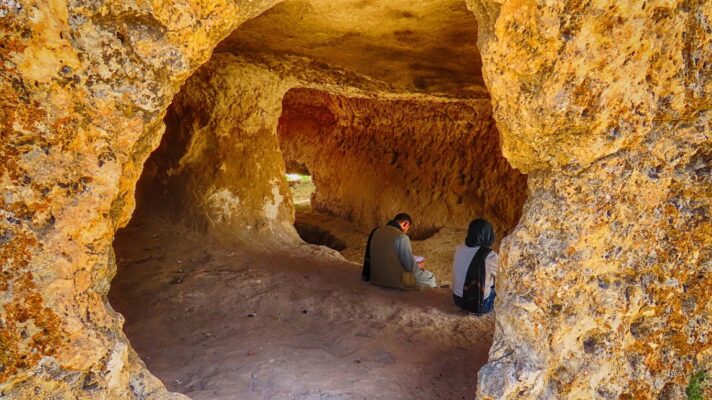
See more: The Silver Coffin of King Psusennes I: A Marvel of Ancient Egypt
The Discovery of Ghaznavid Coins
The Hoard of Ghaznavid Coins: A Surprising Discovery
In one of the caves at Takht-e Rostam, a remarkable hoard of Ghaznavid coins was discovered by chance, offering an unexpected glimpse into the later history of the site. This find is significant not only for its historical value but also for what it reveals about the enduring role of Takht-e Rostam in the centuries following its initial construction during the Kushano-Sasanian era.
The coins provide a tangible link to a different era—one where the site continued to serve a purpose long after its original religious function. The discovery suggests that Takht-e Rostam remained a point of interest, whether as a place of spiritual significance, a hub for trade, or even as a military or cultural center, for generations after it was first established.
The hoard of coins found in the cave offers a fascinating window into the complex layers of Takht-e Rostam’s history. While the stupa and sanctuaries speak to the site’s Buddhist origins, the coins from the Ghaznavid period introduce an entirely new chapter, suggesting that the site adapted to the changing political and cultural landscape of Afghanistan over the centuries.
The Ghaznavid Empire: A Power of Central Asia
The Ghaznavid Empire, which ruled from the 10th to the 12th century, was one of the most influential and prosperous empires in the region. It played a crucial role in shaping the history of Afghanistan and the broader Central Asian world. Under the leadership of the Ghaznavids, the empire was known for its military conquests, cultural flourishing, and significant contributions to the spread of Islam across the region. The Ghaznavids were not only powerful rulers but also great patrons of the arts, architecture, and literature.
The discovery of Ghaznavid coins at Takht-e Rostam provides a glimpse into the economic and political activity of the time. These coins, which likely circulated as currency in the Ghaznavid Empire, suggest that Takht-e Rostam may have continued to be a place of exchange or pilgrimage well into the medieval period. The presence of such coins in this ancient Buddhist site indicates a continuity of human activity in the region and underscores the lasting relevance of the location in the face of shifting empires and cultures.
Historical Implications of the Coin Discovery: A Site of Continuing Significance
The discovery of the Ghaznavid coins at Takht-e Rostam adds a significant layer of complexity to the historical narrative of the site. It points to the possibility that Takht-e Rostam was not merely abandoned after the fall of the Kushano-Sasanian Kingdom but instead may have remained an active site for centuries. This could have taken the form of a pilgrimage destination for those seeking spiritual solace or enlightenment, especially given the site’s Buddhist origins. Alternatively, the complex might have served as a commercial center or even a strategic location for the Ghaznavids during their expansionist campaigns.
The coins, scattered within one of the site’s caves, could imply that Takht-e Rostam was a place where traders, pilgrims, or travelers passed through, contributing to the continued cultural and economic significance of the area. Furthermore, the site may have also acted as a military outpost or refuge during times of conflict, offering a safe haven for those caught in the political turbulence of the Ghaznavid period.
This discovery challenges the notion that ancient religious sites such as Takht-e Rostam are solely relics of a single era. Instead, it suggests that Takht-e Rostam remained an important cultural landmark, adapting to the changing needs of different civilizations and continuing to play a vital role in the region long after its original Buddhist purpose had faded. This connection between the ancient and medieval periods enriches our understanding of Takht-e Rostam, transforming it from a simple Buddhist monument into a living site with a dynamic, multifaceted history.
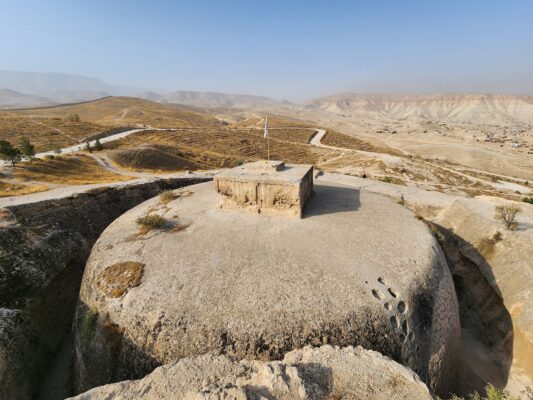
Conclusion
Takht-e Rostam stands as a remarkable testament to the historical and cultural richness of Afghanistan. The complex, with its blend of Buddhist architecture, artistic elements, and historical significance, provides valuable insights into the religious and cultural life of the Kushano-Sasanian Kingdom. The discovery of Ghaznavid coins further highlights the site’s enduring importance through the centuries. Takht-e Rostam remains a symbol of the region’s fascinating history and the evolution of Buddhist influence in Central Asia.

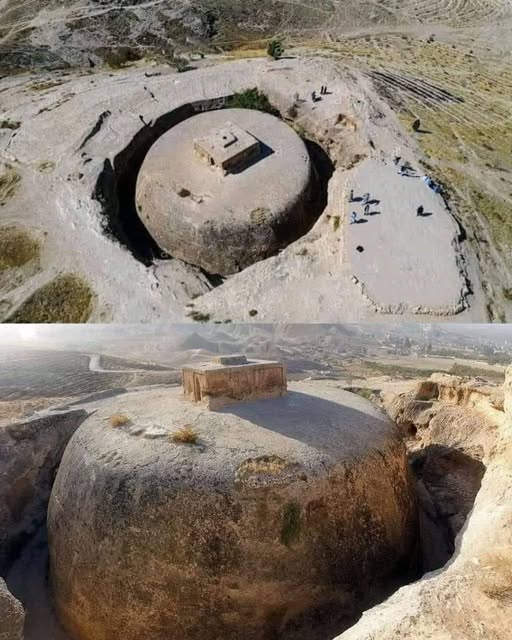
CÁC TIN KHÁC
Mary Walton: The Forgotten Inventor Who Helped Clean Up America’s Cities
Tomb of Queen Nefertari in the Valley of the Queens, Egypt
Discover the Hypostyle Hall of the Temple of Hathor at Dendera
Venus de Losange: Unveiling the Mystery of a 20,000-Year-Old Paleolithic Icon